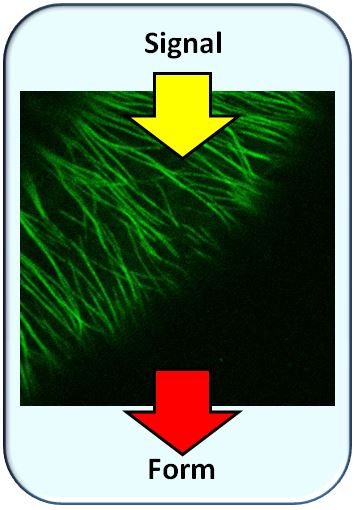Microtubules link signals with shape
What is the topic?
Microtubules are generally known as building blocks of the division spindle. Less known is, however, that at first they were not recognised. Microtubules were discovered in plant cells - 1963 by Ledbetter and Porter. Curiously, they were predicted, one year earlier, by the biophysicist Paul Green (1962). He adopted a physical viewpoint upon the growth of plant cells and stated that the uptake of water into the vacuole should make plant cells to widen rather than to elongate. From this, he concluded that the cell wall must differ in their extensibility depending on direction, they should be stiffer in the transverse compared to the longitudinal axis of the cell. Therefore, the cell must be endowed with a mechanism to steer the direction of cellulose fibres in the cell wall. This mechanism, he reasoned, should depend on minute tubules ("micro-tubules"). These "micro-tubules " were then, in fact, discovered one year later using the emerging technology of electron microscopy. Only years later, it turned out that also the division spindle consists of microtubules.
Plant microtubules, thus, are related to the control of shape. Since plants cannot run away, when they do not like their environment, they only can rely upon adaptation. The ability to change shape is part of this adaptation. How drastically signals can alter plant shape, can be seen in any potato shed, when the potatoes have sprouted - these long and thin, etiolated, shoots put their entire resources into elongation. The biological function is, of course, to reach the light. As soon as the light is reached, elongation stops immediately. Light is also the signal, which makes microtubules respond most swiftly. They change their orientation from transverse to longitudinal, and since microtubules act as tracks for the enzymes that produce cellulose, the cellulose fibres are now longitudinal as well. As a result, the cell will not elongate, but expand in lateral direction. In the dark, microtubules are transverse, which is the mechanistic cause for the rapid elongation of etiolated shoots.
This work surveyed the entire then available knowledge on the responses of microtubules to different environmental signals such as light, gravity, mechanic stimulation, or microorganisms, and addressed the question, to what extent these responses are mediated by plant hormones, and how they are integrated into the biology of plants. Even after almost two decades, this work is still quoted, because it considers the classical knowledge about plant signal responses.
Publication
[3] Nick P (1998) Signalling to the microtubular cytoskeleton in plants. Int Rev Cytol 184, 33-80 (54 Zitate, Stand 27.12.2015) - pdf

